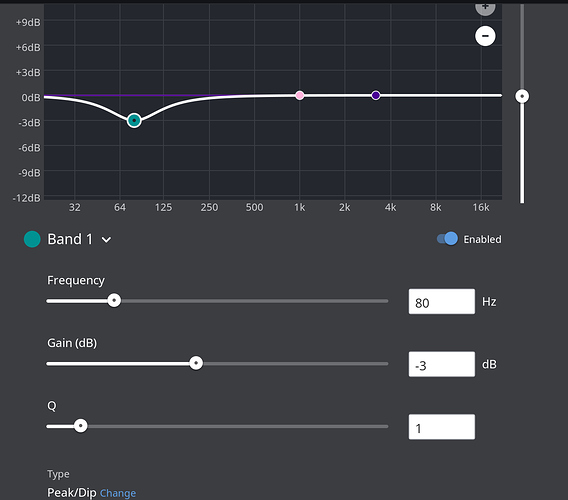Hi I have too much sloppy vibrating bass from my system in my room (amphion argon 3, mytek liberty and primaluna prologue premium amp). I’ve moved speakers well away from wall. I think it’s the suspended wooden floor in my old house and too many windows. I’m new to roon and don’t understand eq principles. What simple fix can I try in dsp to trim the bass while doing as little as possible damage to rest of the sound? Sorry if this is naive question! Thanks!
The easiest place to start would be using simple parametric equalization. To be as quick and easy as possible you could simply lower the bass in the areas you feel are too boomy/sloppy.
As you probably appreciate this whole process can get really deep. But a couple other levels that should be explored eventually:
- measure the frequency response in your room. This can be simple with a Radio Shack SPL meter and something that will give different frequency outputs (I used Stereophile’s CD, back in the day). This gives you a better idea of what areas are too pronounced. You’ll almost certainly see areas that are sucked out too. You will be much more productive using this to guide speaker placement than guessing at it by ear (at least it was for me). I also found that my listening position was a big deal. Room treatments can also be added.
- Another level is to use software that will do frequency sweeps. This is a lot more visual, but you’ll need a microphone.
- Best would be using software that can create convolution filters. This gives you much better precision controlling the peaks and valleys in frequency response. They can often be pretty close together, and parametric equalization can’t get that refinement. That said, the software for this (e.g. Acourate) is pretty demanding.
Personally, I think the benefit/price ratio for getting the room right is higher than almost any other thing you can do with your system. So time here is well spent.
It’s perhaps also worth being aware that there are professionals who will do this for you if you don’t fancy diving in yourself (no connection, other than as a customer). See also this thread..
If you’re having a go yourself then hopefully the comments from @grossmsj will get you started. There’s also a Roon blog by @Magnus on DIY room correction.
This thread really helped me. I purchased the microphone as suggested and went through the process. Its a bit fiddly the first time around but @Magnus was really helpful.
Having used DSP fairly extensively I’d say PEQs get you most of the way there and is much easier to implement and much more flexible.
If you had a mic things would be much easier and are a great investment - you might not use it much but it’s there when you need it. You can also run ‘sweeps’ and just listen and there are loads of ‘setup’ type CDs or available on tidal etc where you can play specific frequencies (good and enlightening for hearing tests too and just clarity on what frequencies are what - I was way out on lots).
With PEQ where I failed most with ‘generic by ear’ type curves in the early days is mainly that the L and R are often quite different which is why it’s hard to hear and EQ both at the same time. Really you need to listen to L and R separately and do L and R PEQs
Im not a foo guy, but personally found isoacoustics footers help with suspended floors, isolation being much more effective than spiking (coupling). But the floors can still resonate and the room nodes will still be there.
It’s fun just to experiment with PEQ. Turn it on and mess around - try reducing rather than boosting to start with until you’re more familiar. You can cut entire frequency ranges and see what effect it has. Sometimes less bass can = more bass.
Plenty on this forum and others to read up on.
You could start by trying an 80Hz cut of between 3 and 6dB (-3 to -6) with a fairly wide Q of 1.
A bit like the following…
You could try a “low-shelf” instead of the “peak/dip” type and see how that sounds.
Look at placement again. I found rational speaker placement which is on offset of master set very useful. Follow this guy it does work but takes time to get it right. I’m nearly there but still needs fine tuning.
- Using the RS SPL meter is very tedious and far from accurate.
- Yes, using software is a good idea but you can use REW (which is free) and buy a miniDSP UMIK-1 for less than $100.
- See above.

